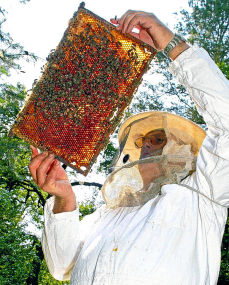In 2009 35 beekeeping operations from 6 federal provinces of Austria reported incidents of suspected bee poisoning to the Institute for Apiculture of the Austrian Agency for Health and Food Safety (AGES). For 33 of these operations beekeepers expressed the suspicion of an bee poisoning incident. The appearance of honey bees with symptoms of poisoning coincided to a high degree with the corn sowing period.
A detectable contamination with the investigated insecticidal seed coating materials was found in 24 (= 83%) of the 29 analysed bee samples and in all of the 14 analysed plant samples. Out of 60 analysed bee bread samples 39 (= 65%) were contaminated with detectable residues of insecticidal seed coating materials. The percentage of samples with detectable clothianidin residues was higher (64 %; 36 investigated samples) in bee yards with suspected poisoning than in yards without suspected poisoning (46 %; 24 investigated samples). In 2010, incidents of suspected bee poisoning for the time between spring inspection of the bee colonies and report deadline (November 15th, 2010 ) were reported from 76 beekeeping operations to the Institute of Apiculture. Most of the beekeepers supposed the sowing of corn as the primary cause. In 89 bee samples analysed for insecticidal seed coatings clothianidin was detected in 51 %, thiamethoxam in 23 %, fipronil in 14 % and fipronil-sulfone in 9 % of the samples.17 plant samples from the off crop area of corn fields were analysed for insecticidal seed coatings. Clothianidin was found in 35 %, thiamethoxam in 18 % and imidacloprid in 18 % of the samples. 34 and 19 pooled samples of beebread which were sampled after corn sowing or after corn blooming period, respectively, from beeyards with suspected poisoning incidents gave positive results for clothianidin in 74 % and 37 %, thiamethoxam in 24 % and 16 % and imidacloprid in 3 % and 11 % of the samples, respectively.
Source: Untersuchungen zum Auftreten von Bienenverlusten in Mais- und Rapsanbaugebieten Österreichs und möglicher Zusammenhänge mit Bienenkrankheiten und dem Einsatz von Pflanzenschutzmitteln (Projekt-Akronym: MELISSA). Dritter Zwischenbericht (Datenlage zum Stichtag 15.11.2010)
https://www.dafne.at/prod/dafne_plus_common/attachment_download/db6ebd7…

- Log in to post comments
